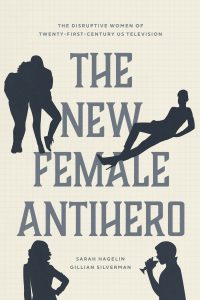Read an Excerpt from “The New Female Antihero”
As we settle in for the cold winter months in Chicago, many of us turn to our favorite television shows for entertainment. Whether streaming an old favorite or trying a new series, we’ve all certainly run across some interesting—and divisive—characters. In their new book, Sarah Hagelin and Gillian Silverman zoom in on a key figure in television history: the female antihero. The last ten years of television have seen a shift in storytelling toward increasingly complex storylines and characters. Far from the sunny, sincere, plucky persona once demanded of female characters, the new female antihero is often selfish and deeply unlikeable. Examining the devious schemers of Game of Thrones, The Americans, Scandal, and Homeland, and the joyful failures of Girls, Broad City, Insecure, and SMILF, Hagelin and Silverman show how these characters give us new ways of imagining women’s lives in contemporary America.
We’re pleased to share a brief excerpt from The New Female Antihero, available now.
Prologue
Elizabeth Jennings, Hannah Horvath, Olivia Pope, Nurse Jackie, Patty Hewes, Annalise Keating, Chris Kraus, Cookie Lyon, Fleabag, Nadia Vulvokov, Gemma Teller Morrow. The last ten years have presented television viewers with a host of female characters the likes of which we’ve never seen before. Selfish, vengeful, often deeply unlikeable, they fly in the face of our expectations for women. They murder without justification; they pursue sex with abandon; they reject marriage, children, and even job security. Yet still they survive—from week to week, episode to episode—often garnering large fan bases even as they shock and disappoint. These women are the outlaws and outcasts of contemporary TV—the new female antiheroes.
For viewers like us—raised on Mary Tyler Moore, Roseanne Barr, and Ellen DeGeneres—this kind of female figure is thoroughly unfamiliar. Watching television in the 1970s, ’80s, and ’90s, we thought we had seen a wide range of heroines: funny women, scheming women, women more interested in their careers than in relationships. But what passed for transgression then seems, from the vantage point of today, to be deeply conventional. Linda Carter’s Wonder Woman was strong but also (as her costume revealed) relentlessly feminine; Murphy Brown was brassy but also completely committed to playing by the rules; Carrie Bradshaw refused to settle but also couldn’t get past the dream of marriage and white picket fence (or co-op apartment, in her case). This earlier generation of female protagonists was defined more than anything by their pluck—they were willing to ask their bosses for raises, sleep with men out of wedlock, and gun down bad guys. Impressive, but a far cry from the murderous cruelty of Game of Thrones’ Cersei Lannister or the abject delusionalism of Enlightened’s Amy Jellicoe.
Today’s female antihero is fundamentally different from the television leads that preceded her, characterized not by pluck but by punch and pathos. In the dramas of the new millennium, she’s murderous, ambitious, and conniving; in comedies she’s selfish, self-sabotaging, and anti-aspirational. Her signature move (in both genres) is a wholesale rejection of virtue and social responsibility—those burdens of a “civilized” society that fall disproportionately on women. Her willingness to flout these norms—to refuse the part of role model and transmitter of values—makes her a target for those who see in the antiheroic woman (far more than in her male counterpart) a dire threat to the social order. And yet to her fans, the female antihero promises a shift away from discipline, achievement, and decorum at a time when society demands increasingly more from women. The disruptive women of twenty-first-century television thus constitute a challenge to the status quo and a revolt against the burdens of being female in contemporary America.
The new female antihero dramas that we examine in this book—Game of Thrones (HBO, 2011–2019), The Americans (FX, 2013–2018), Scandal (ABC, 2012–2018), and Homeland (Showtime, 2010–2020)—reject such puritanical policing. Carrie Mathison and Daenerys Targaryen unabashedly use sex to gain leverage and pleasure, while Cersei Lannister and Olivia Pope down endless amounts of red wine and remain perfectly in control.
The comedies of the new millennium also tell a new tale. Girls (HBO, 2012–2017), Broad City (Comedy Central, 2014–2019), Insecure (HBO, 2016–present), and SMILF (Showtime, 2017–2019) feature familiar characters—female friends in New York City, single African American women, working-class moms—but cast them in a fundamentally different light: apathetic instead of ambitious, trapped instead of triumphant.
What is the origin of this new female antihero and why has she arrived on our screens at this moment? In this book we argue that this emergent protagonist is an ambivalent response to the achievements and failures of liberal feminism—the great strides made in the last fifty years and the lingering knowledge that women are still struggling. An inherently skeptical figure, the new female antihero questions not only the truth of the popular story of female empowerment but also its desirability, the extent to which entitlement, choice, and “leaning in” constitute a meaningful feminist agenda. According to recent cultural narratives, our present moment represents “the end of men”—a time when women have become “the richer sex” and boys are “adrift” and in “crisis.” While these accounts have been powerfully critiqued, they remain part of a cultural zeitgeist in which, as Suzanne Leonard puts it, “women routinely serve as symbols of financial vitality” during a post-recessionary moment when most are still struggling. We contend that the female antihero disrupts this narrative of progress and resiliency. Unlike the television protagonists who preceded her, she’s rarely plucky, resourceful, or game. She asks, often belligerently, what if I don’t want to have it all—career, marriage, children, friends? What if I reject the responsibility of shepherding broken men and a beleaguered economy into the twenty-first century? What if I only want raw naked power? Or, even worse, absolutely nothing?
What happens, then, when we flip the script, when women become not the domesticating keepers of the hearth but the chaotic forces of social upheaval? Can they write their own codes of conduct and still retain audience allegiance? Certainly, the needle is harder to thread. Given the central role of women in social reproduction—homemaking, the nuclear family, middle-class respectability—the female version of the anti-hero represents a far more profound threat to the status quo. Her smallest infractions are parsed for their challenge to feminine social norms, a phenomenon that’s amplified for women of color. By contrast, the male antihero reinforces masculinity with every murder, sardonic joke, or takedown of his boss. This book investigates the uneven consequences of social transgression on television—how gender and race impact displays of fractiousness and excess. It proposes that the new female antihero—antisocial, nonconformist, self-involved—represents an alternative for viewers at once beset by the mounting demands placed on young women and tired of watching men have all the fun. These protagonists, we argue, push back against the myth of the modern-day superwoman—she who “has it all”—and in so doing expand the possibilities for being female in contemporary America.

Sarah Hagelin is associate professor of English and director of women’s and gender studies at the University of Colorado Denver. She is the author of Reel Vulnerability: Power, Pain, and Gender in Contemporary American Film and Television. Gillian Silverman is associate professor of English and director of graduate studies at the University of Colorado Denver. She is the author of Bodies and Books: Reading and the Fantasy of Communion in Nineteenth-Century America.
The New Female Antihero is available from our website or from your favorite bookseller.
